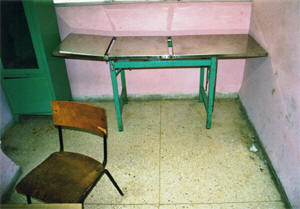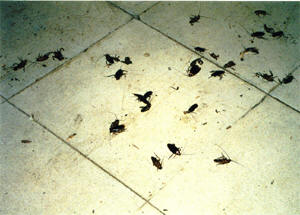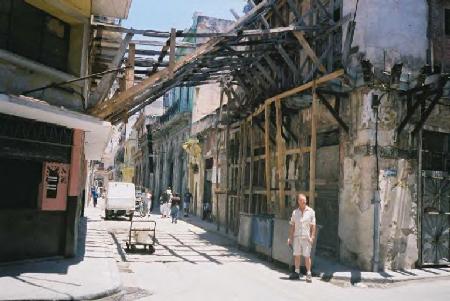|
Home
|
The Plot Thickens More trade between fidel and hugo Cuba will purchase foodstuffs including canned sardines, gelatin, and condensed milk as well as work clothes and boots "for an initial sum of US$412 million," according to the Official Gazette, a government publication listing the details of recently approved diplomatic deals and legislation. The Venezuelan goods exported to the communist-led island will be "exonerated of all taxes" and "given preferential treatment within the policy of economic and social development" in Cuba, stated the Gazette. hugo and fidel signed the deal back in April, but details have just been released. At the same time, Venezuela raised the amount of oil it's selling to Cuba to 90,000 barrels a day - at a preferential price .Cuba promised to send 30,000 doctors to Venezuela. It's widely considered that Cuban doctors are actually intelligence agents. The goods Cuba is purchasing seem rather pitiful to me. Canned sardines just off the Gulf Stream? Just what has fidel done to Cuba's economy? A lot of folks think Cubans traded some of their freedoms for education and healthcare. It turns out that's not true at all. In 1958, Cuba had one of the best healthcare systems in the Americas, third only to the U.S. and Canada. From a study at Florida International University: PUBLIC HEALTH: In 1958, Cuba had a population of six million, six hundred thirty one thousand inhabitants (6,630,921, to be exact). At that time, there were 35 thousand (35,000) hospital beds in the country, an average of one hospital bed per 190 inhabitants, a number which then exceeded the goal of developed countries, which was 200 inhabitants per hospital bed. In 1960, the United States had one hospital bed per 109 inhabitants. Also in 1958, the Cuban nation had an average of one doctor per 980 inhabitants, a number that was surpassed in Latin America only by Argentina, with one doctor per 760 inhabitants, and Uruguay, with one per each 860. Cuba had one dentist per 2,978 inhabitants then. Thanks to therealcuba.com, here are a couple of photographs of a modern Cuban examination room, complete with roaches: Quite an improvement, fidel. Cubans were also well educated - from the same study: EDUCATION: That same year, Cuba had three government financed universities and three others that were privately run. There were twenty thousand (20,000) students enrolled in the government run universities. There were 900 officially recognized private schools, including the three private universities. The total number of students enrolled at these institutions was over one hundred thousand (100,000). The public school system employed twenty five thousand (25,000) teachers, and the private school system counted with 3,500. In the middle of the 1950s, there were 1,206 rural school houses in Cuba, as well as a mobile library system which boasted a total of 179,738 books. Also in 1958, Cuba had 114 institutions of higher education, below the university level; among them were technical institutes, polytechnic and professional schools, which were financed by the government. Just in 1958, these institutions graduated 38,428 students. In 1958, the island's illiteracy rate was 18%. This data is found in the archives of Cuba's Ministry of Education. Cuba was the Latin American country with the highest budget for education in 1958, with 23% of the total budget earmarked for this expense. It was followed by Costa Rica (20%), and Guatemala and Chile, each with 16%. This data comes from America in Statistics, published by the Pan American Union. And look at this photograph. again from therealcuba.com: I'm old enough to remember 1958, and I'll assure this photograph could have been taken in any medium to large city in the United States. Woolworth's ten-cent store is the same, the bus is the same, the clothes are the same. Look at Havana now: John at reasonovermight (thanks for the link babalublog.com) has stunning figures on the decline of Cuba since 1959. Please read the whole thing - I'll only excerpt a few of the numbers. Cuba's population has doubled since 1959, but per capita income has shrunk from $1200 per year to $70 per year. The number of telephones per 100 people was 15 in 1959 - and is only 3 and a half now. If you've wondered why fidel had to find energy efficient rice cookers, it's because under his rule, per capita electricity consumption has shrunk from 450 in 1959 to only 75 in 2004. (John says the figure is in watts, but I suspect it's kilowatts.) John goes on to write: How daft would you have to be to emulate such an economic/political model? Very daft indeed, I should say. It is simply incomprehensible to me that a leader could choose the worst role model instead of the best as an example for his country to follow. Unless, of course, that leader does not have the best interests of his fellow citizens at heart at all, but rather follows personal goals of his own, such as power, money, and recognition from revolutionary has-beens in Cuba and some European circles. I am still not decided on whether Venezuela's Chavez is malevolent or merely deluded, or perhaps a dangerous mixture of both. But about one thing there can be no doubt: He is putting Venezuela on a seriously wrong track and needs to be stopped. Why, indeed, hugo? Update - Dennis shares his thoughts here. |
 Cuba says it will spend $412-million dollars (US - euro340-million) on goods from Venezuela.
Cuba says it will spend $412-million dollars (US - euro340-million) on goods from Venezuela. 

